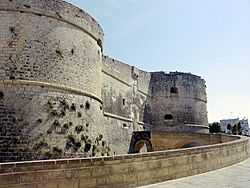Ottoman invasion of Otranto facts for kids
The Ottoman invasion of Otranto happened between 1480 and 1481. It took place in the city of Otranto, which is in southern Italy. Soldiers from the Ottoman Empire attacked and surrounded the city. They captured Otranto on August 11, 1480. This was the first time the Ottomans had a base in Italy.
A famous story says that more than 800 people were killed after the city was taken. These people are known as the Martyrs of Otranto and are still remembered in Italy. About a year later, the Ottoman soldiers gave up the city. This happened after Christian armies surrounded Otranto again. It also happened because the Ottoman sultan, Mehmed II, had died, causing confusion. Papal forces, led by Paolo Fregoso, also helped in the recapture.
Quick facts for kids Battle of Otranto |
|||||||
|---|---|---|---|---|---|---|---|
| Part of the Ottoman wars in Europe and Ottoman–Hungarian Wars |
|||||||
 Castle of Otranto |
|||||||
|
|||||||
| Belligerents | |||||||
|
|||||||
| Commanders and leaders | |||||||
| Gedik Ahmed Pasha |
|
||||||
| Strength | |||||||
|
|
||||||
| Casualties and losses | |||||||
| Garrisoned forces surrender |
|
||||||
Contents
Why the Ottomans Attacked
The attack on Otranto was part of a bigger plan. The Ottoman Empire wanted to invade and take over more of Italy. Their main goal was even to reach Rome.
In the summer of 1480, about 20,000 Ottoman soldiers arrived in southern Italy. They were led by a commander named Gedik Ahmed Pasha. The first step in their plan was to capture the port city of Otranto.
Before this, the Republic of Venice and the Ottoman Empire had fought a long war. This war lasted 15 years and was about who controlled trade in the Mediterranean Sea. The war had just ended with a peace agreement.
The Invasion of Italy
The Siege of Otranto
On July 28, a large Ottoman fleet arrived near Otranto. It had 128 ships, including 28 galleys (a type of ship powered by oars). Many of these soldiers had just come from another battle. This was the Siege of Rhodes.
The soldiers defending Otranto and the city's people went into the city's castle for safety. After 15 days, on August 11, Gedik Ahmed Pasha ordered a final attack. The Ottoman soldiers broke through the city walls. They went from house to house, stealing things, destroying property, and setting fires.
When they reached the main church, the cathedral, they found the Archbishop and other leaders. They were waiting with the people, praying. Sadly, about 12,000 people were killed. Another 5,000 were taken as slaves. The cathedral was even turned into a mosque.
The Martyrs of Otranto
The people who were killed in Otranto are known as the Martyrs of Otranto. The Roman Catholic Church officially recognized them as saints on May 12, 2013. Their remains are believed to be kept in Otranto Cathedral today. Some are also in a church in Naples.
The traditional story says these people were killed because they refused to give up their Christian faith. However, some historians have different ideas. They suggest the killings might have been a way to scare people and show Ottoman power.
The Ottoman Advance Stops
After taking Otranto, the Ottoman forces attacked other coastal cities. These included Vieste, Lecce, Taranto, and Brindisi. They even destroyed a monastery that held a very rich library.
However, the Ottoman commander, Gedik Ahmed Pasha, faced a problem. He didn't have enough supplies to keep going. So, he decided to return to Albania with most of his soldiers. He left a smaller group of 800 foot soldiers and 500 cavalry (soldiers on horseback) to protect Otranto. He planned to come back with his full army after winter.
Otranto is Recaptured
Between August and September, King Ferdinand of Naples tried to take Otranto back. He got help from his cousin, Ferdinand the Catholic, and the Kingdom of Sicily. Christian armies surrounded the city on May 1, 1481.
Meanwhile, Sultan Mehmed II was getting ready for another attack on Italy. But he died on May 3. His death caused problems about who would rule next. This meant the Ottomans couldn't send more soldiers to Otranto.
After talking with the Christian forces, the Ottomans in Otranto gave up. They left the city in September 1481. This ended their 13-month control of Otranto.
What Happened Next
Before the invasion, Otranto had about 20,000 citizens. By the end of the century, this number had dropped to only 8,000.
The Ottomans did briefly control Otranto one more time. This happened in 1537.
See also
 In Spanish: Sitio de Otranto para niños
In Spanish: Sitio de Otranto para niños
- History of Islam in southern Italy
- Martyrs of Otranto
- Da Vinci's Demons (a TV show that includes parts of this invasion)

